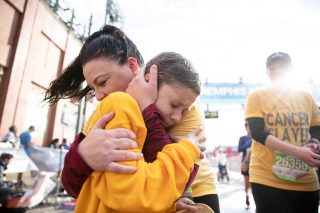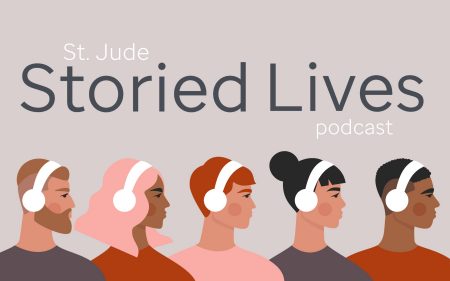
From clinical trials to cures: a breakdown of research at St. Jude
Kinlee's journey with medulloblastoma shows how research in the labs at St. Jude Children's Research Hospital can translate to better outcomes for patients.

May 23, 2022 • 10 min

It was summer in Georgia when the red clay ballfields emit unforgiving heat and dust. So, Nicole wasn’t surprised when her 7-year-old daughter, a competitive softball player, complained that her head hurt and that she was tired, her vision hazy. After six straight tournament games, the mother herself had to admit the heat was getting to them both.
But then, even as summer slipped into autumn, the headaches persisted. They were worse, more frequent. And in one game, running to home plate, Kinlee lost her balance, fell and crawled to base, dizzy and disoriented. Afterward, she was so nauseous and shaky on her feet that she missed school and skipped games with her beloved team.

Nicole knew then Kinlee’s condition was serious. But when she and her husband took Kinlee to the hospital in Atlanta, nothing could have braced them for the diagnosis doctors delivered.
Medulloblastoma.
Fewer than 500 children in the United States are diagnosed with this type of brain cancer each year. In the fall of 2017, Kinlee was one of them. Kinlee had a tumor the size of a golf ball in her brain and she’d need immediate surgery.
“Never in a million years did I ever think that they were going to tell my husband and me that Kinlee has brain cancer. Never ever,” Nicole said. “Right then and there, my entire world just completely shattered.”
“I fell to the floor,” she said.
As this one Georgia couple buckled beneath the weight of a difficult diagnosis and imminent surgery, doctors and scientists 400 miles away at St. Jude Children’s Research Hospital in Memphis were developing ways to better understand, classify and treat medulloblastoma.
The disease had proved inscrutable for even the world’s most renowned cancer doctors and researchers for decades and stubbornly posted dismal survival rates despite seminal advances in surgery and radiation techniques. But the St. Jude brain tumor program, running since 1985, had seen promising gains in a series of clinical trials since 1996 that better defined the disease and its effects on patients.
A clinical trial is a carefully planned research study to test new medicines, experimental combinations of therapies or procedures. Right now, at St. Jude, over 135 clinical trials are helping turn scientists’ discoveries into new, better treatments for children with cancer and other life-threatening diseases both on the Memphis campus and around the world. The medulloblastoma trials are part of that body of work.
These trials seek to answer key questions:
• What is medulloblastoma at a molecular level?
• Does it behave differently in some patients and if it does, why is it more aggressive in some kids and not others?
• Could radiation therapy and chemotherapy be reduced, even eliminated, based on the type of medulloblastoma a child has, to diminish the serious side effects kids often suffer?
• How do you kill a disease, save a child and preserve good quality of life simultaneously?
Giles W. Robinson, MD, a neuro-oncologist and associate faculty member at St. Jude, is one of the doctors leading research in this area. Near the end of 2017, a family from Georgia signed their daughter up for Robinson’s clinical trial.
They signed on because they had heard St. Jude was among the only pediatric hospitals in the country offering the more precise proton radiation to treat medulloblastoma. Traditional radiation delivers x-rays, or beams of photons, to the tumor and beyond it. It kills tumors, yes, but also wreaks havoc on nearby healthy tissues and organs, causing significant side effects.

But this family learned that St. Jude doctors treating medulloblastoma increasingly rely on proton therapy, which delivers a beam of proton particles that stops at the tumor, so it's less likely to damage nearby healthy tissues. Medulloblastoma tumors are mostly in children’s developing brain and spine, so it’s particularly important to preserve healthy tissues that are critical to learning, movement and coordination.
This family told St. Jude staff in the brain tumor program about their little girl, how she was a gifted reader in school and a strong, talented softball player. The family wanted to treat their daughter in a place that would not only save her, but help her retain some of the qualities that made her the athlete and star student she’d always been. Her name was Kinlee.
Part 2: The science behind the cures
Dr. Robinson hadn’t expected to settle at St. Jude. He had planned to stay in Denver, Colorado, where he was training, or return to the Northeast and work in hospitals there, putting down roots close to family. But then he received a letter from St. Jude. It was an invitation to see if he might want to train at one of the most prestigious childhood cancer research hospitals.
Not wanting to waste the opportunity to learn how to treat the diseases he was most interested in, he came to Memphis nearly 16 years ago. He never left.
Robinson was moved by the patient care he witnessed and impressed by the legion of loyal donors who continuously support the work taking place in the labs and clinics. He was eager to work with the dogged researchers he believed would develop the unique and powerful therapies necessary to ultimately arrive at a cure for this disease.

“What makes us unique is that we conceive, launch and run our own clinical trials,” Robinson said.
This model, he said, allows St. Jude to bring patients and collaborators care that is not available anywhere else. There’s a sense of urgency behind this work, too. After decades of steady rise — in part facilitated by research led at St. Jude — cure rates for pediatric cancer plateaued over the last decade. So, St. Jude increased investment in basic science research and clinical trials to develop newer, more effective and less toxic therapies, hoping to boost cure rates.
This robust investment in research gives St. Jude scientists and doctors data, projects, grants and publications that share knowledge of the latest findings with colleagues and clinics across the world. It also leads to in-house discoveries that cultivate future clinical trials.
Between 2012 and 2021, there was a total of 4200 participants on St. Jude sponsored interventional trials. This is a 27 percent increase over the number of participants in these types of trials between 2002-2011.
Part 3: Evolving the standards of care
In the clinical trial Robinson has run alongside his mentor Amar Gajjar, MD, since 2012, the agents they use to treat medulloblastoma haven’t drastically changed — they still rely on a combination of surgery, radiation and chemotherapy — but they’ve reduced the doses. In some cases, substantially.
In the current trial, Robinson said, St. Jude is testing the reduced dose of radiation on a subset of medulloblastoma patients whose disease is biologically more sensitive to therapy. In this way, Robinson predicts they can still kill the disease while reducing harmful, long-term side effects on children’s physical appearance and movement, cognitive ability and endocrine system.
Robinson sees the proof of these efforts when kids return for checkups a few years after their treatment. Ten years ago, when kids who had survived came back for checkups, they still carried the physical scars and signs of treatment. Their hair had not fully grown back. Their back was hunched, impacted by several rounds of radiation to their spine. They had a strained gait and experienced delays in learning.
These days, when Robinson’s patients who got lower dosing return for post-treatment checkups, they are virtually indistinguishable from their siblings. They’re doing well in school, applying for colleges and jobs. They’re playing sports and lifting weights.
“I get great satisfaction in seeing these patients come back to us and they are living full and healthy lives, doing things we never thought possible,” Robinson said.
This is the type of progress that drew Kinlee’s family to seek care from St. Jude.

They were cautiously optimistic, but not naïve. This would not be easy. Kinlee would be on an arduous protocol involving 30 radiation therapy sessions, four cycles of chemotherapy, blood and platelet transfusions and countless scans to track improvement and decline along the way.
“During that time, I was just, honestly, a lost soul. My daughter had cancer. We're picking up and moving from Georgia to Tennessee. Like, what are we going to do? What's going to happen? I'm scared to death. And I'm just overwhelmed with so many emotions,” Nicole said as she recalled the early days of the decision to join a clinical trial at St. Jude.
“So when St. Jude kind of stepped in, it was like a godsend for us,” Nicole said. “They were able to answer any and every question that we needed. I could email them or call them and I would get answers right then and there.”
On this clinical trial named SJMB12, Kinlee was about to leverage brain tumor research, some of it 21 years in the making and the result of global collaborations with doctors and scientists from Canada, Europe, Australia and New Zealand.
From this research, Robinson knew that the type of medulloblastoma Kinlee had offered a good prognosis, and had designed the trial to reduce and tailor therapy for tumors like Kinlee's to be less toxic.
Whereas medulloblastoma had once been regarded as a single entity and treated as one big, bad disease, research from the scientific community, which included many from St. Jude like Robinson, Gajjar, Paul Northcott, PhD, and David Ellison, MD, PhD, showed it could actually be divided into distinct molecular groups that behave differently in the body.
These molecular groups were given names, some funny, like: WNT (pronounced wint), Sonic Hedgehog, Group 3 and Group 4 to help distinguish them. WNT had the best prognosis and occurred in majority females between the ages of 6-12, while Sonic Hedgehog occurred predominantly in children younger than 5. Group 3 was aggressive and frequently had metastasized, or spread, at diagnosis, while Group 4 was the most common of all, accounting for nearly 40 percent of medulloblastoma.
Doctors, such as Robinson, who had been used to treating every medulloblastoma patient in the same way, increasingly realized they could use these molecular groupings to adjust and modify treatment. This was the impetus behind the SJMB12 trial that was the first to deploy therapy based on molecular classification. Here, Robinson and Gajjar backed off on radiation therapy to the WNT cases, and incorporated new medicines that had traditionally been used for lung and pancreatic cancer, for instance, for the resistant Group 3 tumors. This has allowed St. Jude to offer state-of-the-art therapy to new patients that is more promising and often less toxic than the standard therapy that they would otherwise be offered.
“We know we’re treating many medulloblastoma patients with too much therapy and we know if we can sensibly back off even a little bit to those that don't need it, then that’s what’s going to allow these patients to grow and thrive,” Robinson said.
Part 4: Kinlee's story
As Kinlee prepared for the clinical trial protocol St. Jude developed for her, child life specialists — case workers who help pediatric patients understand and cope with the complex aspects of their diagnosis and treatment — showed her how cancer works using colorful modeling clay.

They rolled clay into tiny balls shaped like tumor cells, malformed and abundant, mimicking the way cancer multiplies in a body. They told her about the tattoos and lines she’d need drawn on her body for MRIs and CT scans. They talked of radiation and about the nausea she’d experience with chemotherapy.
“Obviously, being a child going through harsh treatment, it's very scary. But I was very curious, too, to see what it was going to be like. I was 7, and was curious and into everything,” said Kinlee.
She remembers it crisply, though it was four years ago. Chemotherapy hit her harder than the effects of radiation. Nausea and vomiting made her too weak to climb into bed. She remembers the nurses tilting the bed to help her get in. She suffered complications with her port and was tethered to intravenous tubes for much of her treatment, needles and medical tape tugging and pinching at her sallow skin.
“I have very tiny veins. And so, they kept poking different places. They tried my feet, my wrists, my forearms, everything they could imagine,” she remembers.
Her stocky, muscular build turned wiry and thin as she lost weight and needed a feeding tube.
Reflecting on those difficult times, Nicole posted a message to her friends on social media: Many nights I laid in a shower and cried for what seemed hours. Many nights, I waited until Kinlee would finally get comfortable for a few hours and sleep to have my break down.
And though outwardly it seemed Kinlee was not tolerating the treatment, Nicole remembers the doctors offering optimistic outlooks for Kinlee’s response to the therapy they were trying. Despite appearances, the medulloblastoma was not detectable, they reassured her. They shared charts and graphs with numbers and values that offered early proof Kinlee was overcoming cancer.
“Throughout the entire journey, we had the utmost information on what was going on, what was next, what was about to happen. Even if there was something that we didn't fully understand, they would go print something for us, highlight it, talk to us again to make sure that we understood,” Nicole said. “Communication was key for my husband and I during her treatment.”
Kinlee would start to regain her strength and health over the following months and years, but she needed help getting there.
St. Jude provided Kinlee with a nutritionist and physical therapist, with helpful cooking lessons and exercises offered at the hospital and in patient housing. Eye doctors and specialists to check hearing also treated Kinlee at St. Jude to be sure they helped her manage any side effects of the treatment.
Seven months after she began the trial, Kinlee was declared cancer-free. Scans showed no evidence of disease. She returned to her home in suburban Atlanta with her family and gingerly navigated re-entry to a life that cancer had abruptly halted.
Kinlee couldn’t continue playing with her softball team, which had advanced in her absence. Undeterred, she took up cheerleading. With her mother supporting her as assistant coach, Kinlee doesn’t hold back in training, perfecting her kicks and jumps like the other kids on the squad. At home, she roughhouses with the best of them, wrestling a little brother she calls “a handful,” and chasing after her energetic goldendoodle, Tinnie.
On quiet afternoons, she sketches superhero cartoon characters. She prefers to draw the villains, concentrating on their motivations and features. Like the doctors who cured her cancer, she’s fascinated by what can go awry in a person.
How and why does darkness grow in a person, suddenly corrupting all that is healthy and good? How does it become strong? What does it take to vanquish it?
Kinlee’s mother, Nicole, considers the determination it took for her family to come out the other side and thinks of the next family preparing to travel the same road they did.
“There's somebody walking through these doors right now who was just diagnosed," she said. "And just by us committing and doing a clinical trial, going through everything we did four years ago, we raised that standard to where people can learn from our treatment. Just to know you were part of that, as a mother, to look back on that, it's very fulfilling.
“When I think of clinical trial, I think of research, research and more research. The more that we do research, the closer we are to finding a cure."











